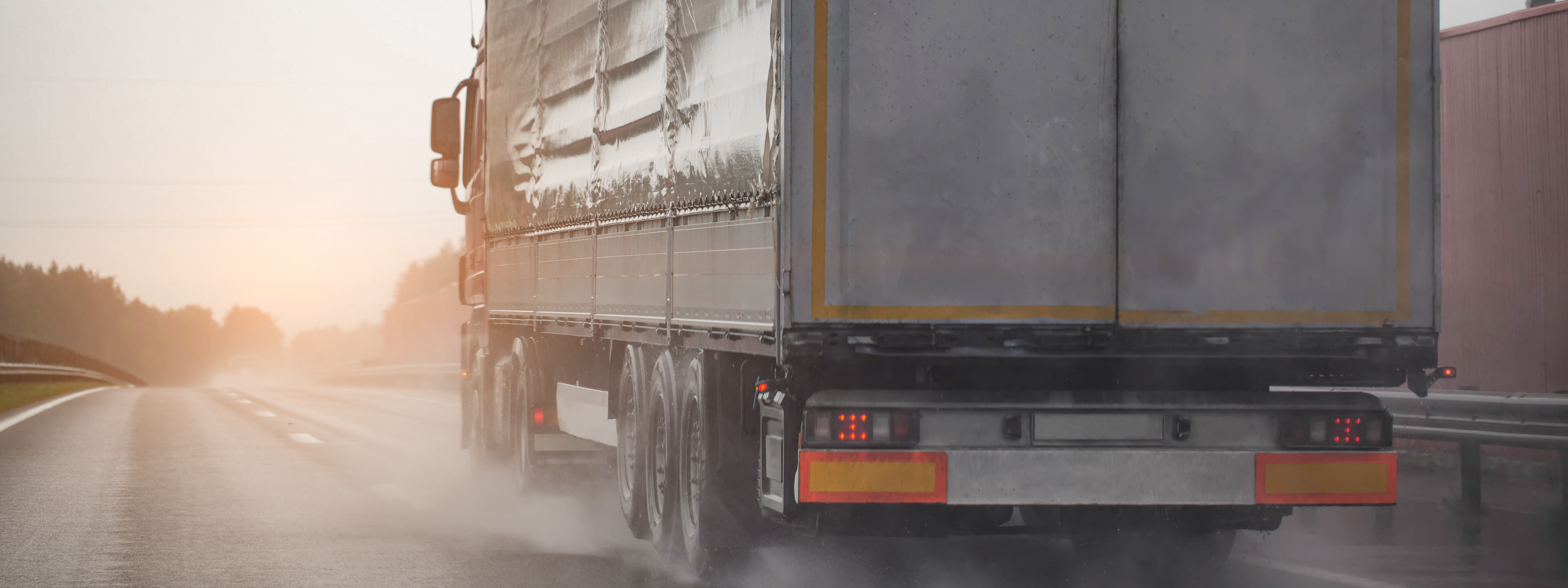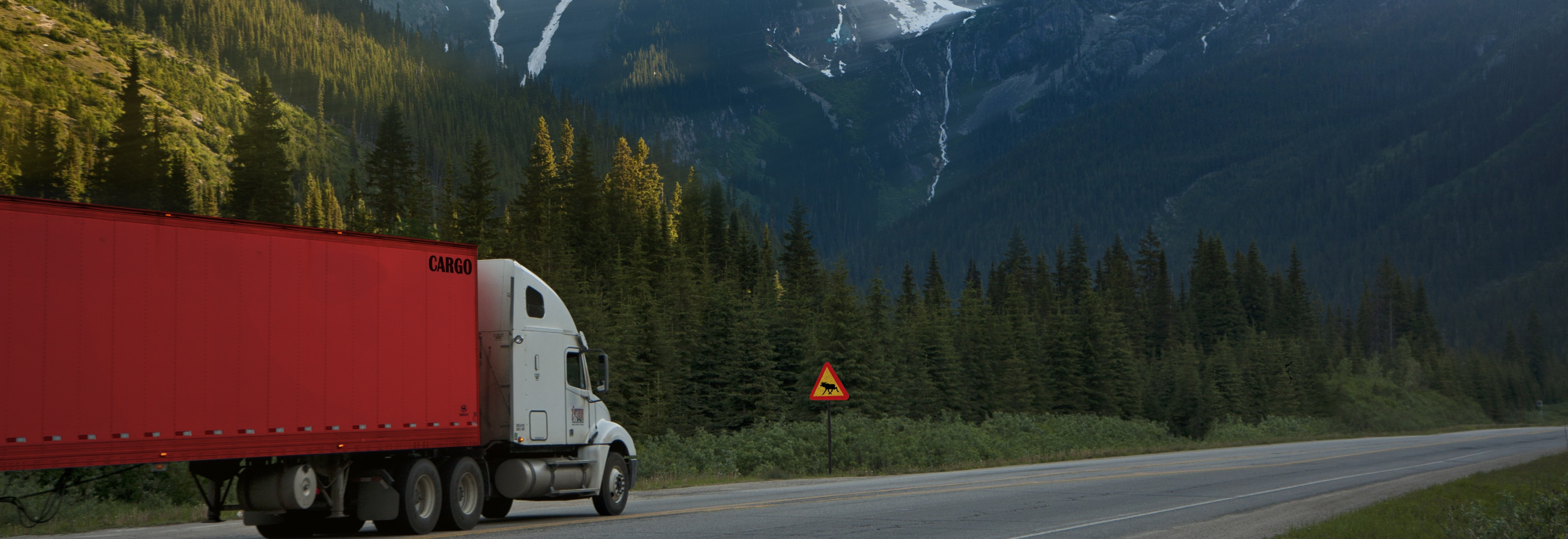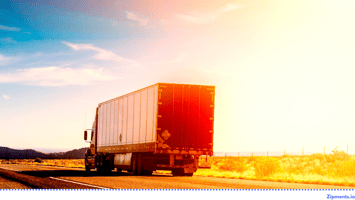Truck drivers are essential to international trade. Between Canada and the United States, there is...
A Truck Driver's Guide To Crossing Into Canada
Trade between Canada and the U.S. is valued at over $1 trillion a year. The border between these two nations is naturally one of the busiest places in the world. With billions of dollars crossing each day, it is also not surprising how many regulations and rules are in place to ensure safety and protocol. For truck drivers, the process can seem like a daunting experience. When driving across borders, it's helpful to know the steps involved and what you should expect, as drivers will need to abide by regulations of each country..png?width=9216&height=3456&name=Blue%20Gold%20Rustic%20Artisinal%20Remote%20Graduation%20Banner%20(1).png)
To help truck drivers safely and legally cross the border into Canada, we've consulted with veteran driver and cross-border wizard Randy Holloway, who has over 17 years experience in the industry and knows what it takes to cross quickly and successfully. He has created a step-by-step guide for drivers crossing the U.S. and Canada border via commercial truck. If you plan on crossing into Canada, here is your detailed guide on all things cross-border:
WHAT IS NEEDED TO CROSS THE BORDER INTO CANADA AND COME BACK
Acronyms and Terms You Need To Know:
| ACI | Presented to CBSA to cross into Canada |
| ACE | Presented to CBP to cross into the US |
| CBSA | Canadian Border Services Agency (Canada) |
| CBP | Customs and Border Protection (United States) |
| PARS | Pre-Arrival Review System (Canada) |
| PAPS | Pre-Arrival Processing System (United States) |
| SCAC | Standard Carrier Alpha Code |
Step 1:
Canadian Highway Carrier Code
The first task is to get a Canadian Carrier Code. This process usually takes about 3-4 weeks. You will apply directly through the CBSA website here, or using the Zipments carrier code application generator.
Canadian Carrier Codes consist of a combination of letters and/or numbers, always 4 characters long. You will need this to order PARS stickers which will be used to cross into Canada. When you apply, make sure to ask for a Shared Secret Value. This will allow you to log onto the CBSA website to do the ACI. Once you get the code, you never have to renew or update unless something changes in your business.
Step 2:
SCAC Code
Unless you already have one, you will need an SCAC code. This is what will be used for PAPS stickers. You can apply for a SCAC code using the NMFTA website.
NMFTA will charge around $75 per year to keep your SCAC active. Renewal is generally around the month of June each year. Once you renew, they automatically send notification to the CBP. Do not allow this to expire or they can issue the code to someone else.
Step 3:
PARS and PAPS Stickers
Once you get your Canadian Carrier Code and SCAC, you will need PARS (for going into Canada) and PAPS (for coming into the U.S.) stickers. These stickers are what you give to a shipper to attach to the customs paperwork. Generally the shipper will send the information to the customs broker. Every shipment that crosses the border either direction must go through a customs broker.
There are several places where you can get stickers. I go through Pacific Customs Brokers (PCB) at the Pacific Highway crossing. Usually order 500 of each at a time. You can also buy labels online using Zipments, including same day emergency labels you can print out.
Some printers will put “PARS” right after the Canadian Carrier Code followed by a number. For example, if my Canadian Carrier Code is 1503, my PARS stickers would begin with 15030001 and go up from there. A different printer might put 1503PARS0001. It's best to keep things simple. The same companies also print your PAPS stickers. We are now looking at the SCAC code for these. If my SCAC is HATP, my PAPS stickers would be HATP10001 and go up from there. They suggest we put a “1" right after the SCAC followed by numbers. PAPS stickers are given to Canadian customers so they can send it to their brokers.
Step 4:
Understanding the Crossings
There are a lot of places you can cross the border, but not all are commercial crossings. Also, titled vehicles (such as trailers) can only cross at certain crossings. Other crossings do not allow commercial vehicles. Some crossings (like Del Bonita MT/AB) are permit crossings. You can cross empty, but if you are loaded you will need prior approval from CBP and CBSA. You will need to tell the customs broker which port of entry you will cross based on which direction you are going. A summary of these ports and their code is toward the end of this document.
One more item that needs to be done before coming into British Columbia is to file an insurance certificate with the Ministry of Insurance of British Columbia. Your insurer should know how to do this. BC will send a letter back showing you have the necessary insurance and give you a certificate with a number. Keep this in your permit book, as BC Port of Entry or RCMP may ask for it.
Step 5:
Have Your Identification Documents
Everyone crossing the border must have a passport or an abbreviated passport that allows you to go to Canada and Mexico. This must be shown every time you cross the border. Standard passports are good for 10 years.
You will also need to file an entry with ArriveCan app. This records your current health condition. Previously, you needed to scan your proof of vaccine card, but as of October 1 that was unnecessary. For commercial carriers, you need to enter that information once, and it is good for several months.
Trucks going into Canada only have to provide their ACI and passport. Coming into the US, they have to pay the crossing fee plus provide an ACE manifest. If you plan on crossing many times, you can get a transponder that allows access for the entire year.
Cost of Crossing: Single crossings are $13.05, but if you buy an annual it is $415. Purchase on the CBP website.
They do not accept cash. You’ll have to either pay the border crossing fee in advance or use a credit card at the border which may take up to 20 minutes.

CROSSING INTO CANADA
After you load, give the shipper a PARS sticker, tell them when and where you will be crossing. The customs broker enters the information. You will need to do an ACI. Go to the CBSA website to do the ACI.
Enter all the information. It takes several steps. Once completed, submit the information and you can print an ACI that you give to the customs person. It is a single page document that has a bar code. The ACI must be submitted at least one hour before arrival at the border.
It is advisable to verify that the submission has been accepted, and the ACI has matched the submission. You can track your submission online. Once it is cleared to cross, proceed to the border. Give them the passport and ACI. The customs agent will ask where you live, where are you going, and how long you will be in Canada. They sometimes ask if you have fresh fruits or vegetables, meats, weapons, or money over $10,000. Then they will stamp the ACI and give it back to you. Keep a copy of this stamped ACI! Occasionally, they may forget to send this information and the shipment will not show as cleared. If you cannot provide a copy of the stamped ACI, they can fine you $10,000. It happens about once every 3-4 months.
COMING BACK INTO THE U.S.
Once you are loaded, give a PAPS sticker to the customer. They will usually send it to their broker.
There are two options to do the ACE. One is to go the the CBP website and enter the information. It is free, but the entries must be exactly perfect. Another option is to use a website called Greeneye.com. They charge $2.50 per entry where the other site is free, but they are much more user-friendly. They can also get set up so you can do both the ACE and ACI on the same site. It is up to you. Once the entry is done, either site will print an ACE manifest. It is also a single page document.
When you get to the border, hand them your passport and the ACE. They will scan the barcode, look at your ACE, ask a few questions (similar to what you were asked coming in) and include if you have anything to declare (purchased items in Canada that may be subject to duty). Answer no to that last question, they will stamp the paperwork then let you go. If you've already paid the annual fee or the single crossing fee, they won't ask you again.

A FEW MORE THINGS TO KNOW:
1. Even if you are empty, you still need an ACI or ACE showing an empty trip. Every crossing requires an ACI or ACE manifest.
2. If you have different pickups and/or different delivery locations, you will need to have a separate PARS or PAPS sticker for each shipment! There will always be only one trip, but there may be 2 or more shipments per trip. For instance, I had one trip that had 5 different PAPS stickers because it was farm machinery going to 5 different locations. But there was only one trip showed on the ACE that showed all 5 PAPS stickers.
3. Customs will occasionally check your load. Never try shipping freight that has not been properly manifested and declared.
4. This information is only for locations in the western US and Canada. If you cross east of Montana, please check for specific rules applicable to your area. For example, the Province of Ontario requires speed limiters on commercial trucks.
In summary, this is what you need to do to get started:
1. Get a Canadian Carrier Code
2. Get a SCAC code
3. Order PARS/PAPS stickers
4. Get set up with CBSA to do the ACI.
5. Get set up with a platform to do your ACE.
Port Codes
|
ACE |
ACI |
|||
|
Highway |
US town (into USA) |
Code |
Canada (Into Canada) |
Code |
|
I-5 |
Blaine, WA |
3004 |
Pacific Highway |
0813 |
|
US 9; BC 1 |
Sumas, WA |
3009 |
Huntingdon, BC |
0817 |
|
Hwy 97 |
Oroville, WA |
3019 |
Osoyoos, BC |
0819 |
|
Hwy 395 |
Laurier, WA |
3016 |
Cascade, BC |
0816 |
|
US25; BC22 |
Frontier, WA |
3020 |
Paterson, BC |
0832 |
|
US95 |
Eastport, ID |
3302 |
Kingsgate, BC |
0818 |
|
US93 |
Roosville, MT |
3318 |
Roosville, BC |
0824 |
|
US89; AB2 |
Piegan, MT |
3316 |
Carway, AB |
0707 |
|
US213;AB62 |
Del Bonita, MT |
3322 |
Del Bonita, AB |
0708 |
|
I-15 |
Sweetgrass, MT |
3310 |
Coutts, AB |
0705 |
For locations east of Sweetgrass MT and Coutts AB, please refer to the CBP or CBSA website.
DRIVING IN CANADA (HOS):
Hours of service rules are different in Canada. You are allowed 13 hours of driving but you must take 10 hours total off duty during a 24 hour period that runs from midnight to midnight. You only need to take 8 hours off duty to restart your 13 hours of driving, but your off-duty time must be in periods of 30 minutes or more.
Canada allows 70 hours of working time in 7 days or 140 hours of working in 14 days. Restart for the 7 day rule is 36 hours and for the 14 day period is 72 hours. If you are caught falsifying your log book, you will be placed out of service for 72 hours.
Canada also requires pre-trip inspection reports and post-trip inspection reports. Failure to do either one will result in a fine of $138.00.
Weight laws are also different. Canada does not allow steerable lift axles. They do allow additional weight per axle and group. Single axles are allowed up to the manufacturers specifications. Tandem axles can haul 17,000 kg (37,400 lbs) and tridems can haul 24,000 kg (52, 800lbs). Spread axle trailers that are common in the U.S. are not recognized in Canada. They are only allowed 20,000 lbs for the two axles. If you bring a tandem axle trailer into Canada, be sure it has an axle group that can be slid together.
If you are interested in cross-border trucking or need any help with your cross border process, you can also reach out to Randy directly through either his LinkedIn profile or via:
Randy L Holloway
Haul-Away Transportation Middleton, ID 83644
Cell: 208-590-4968
Cross-border business relationships are both complex and rewarding. The Canada and U.S. border is the busiest international land border in the world, so there are many regulations and laws in place to ensure safety, security and protocol. Keep these tips in mind the next time you are crossing to make sure the process is smooth and easy. Cross-border trucking can be a stressful experience, but knowing what to expect will make it easier!

.jpg?height=200&name=Red%20Blue%20Neon%20Technology%20Video%20(4).jpg)
.jpg?height=200&name=Business%20Network%20Presentation%20Templates%20(1).jpg)
